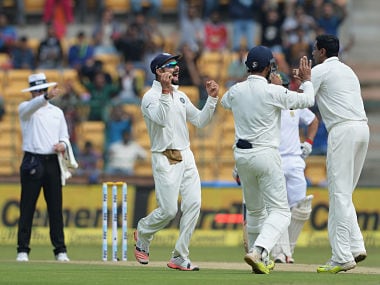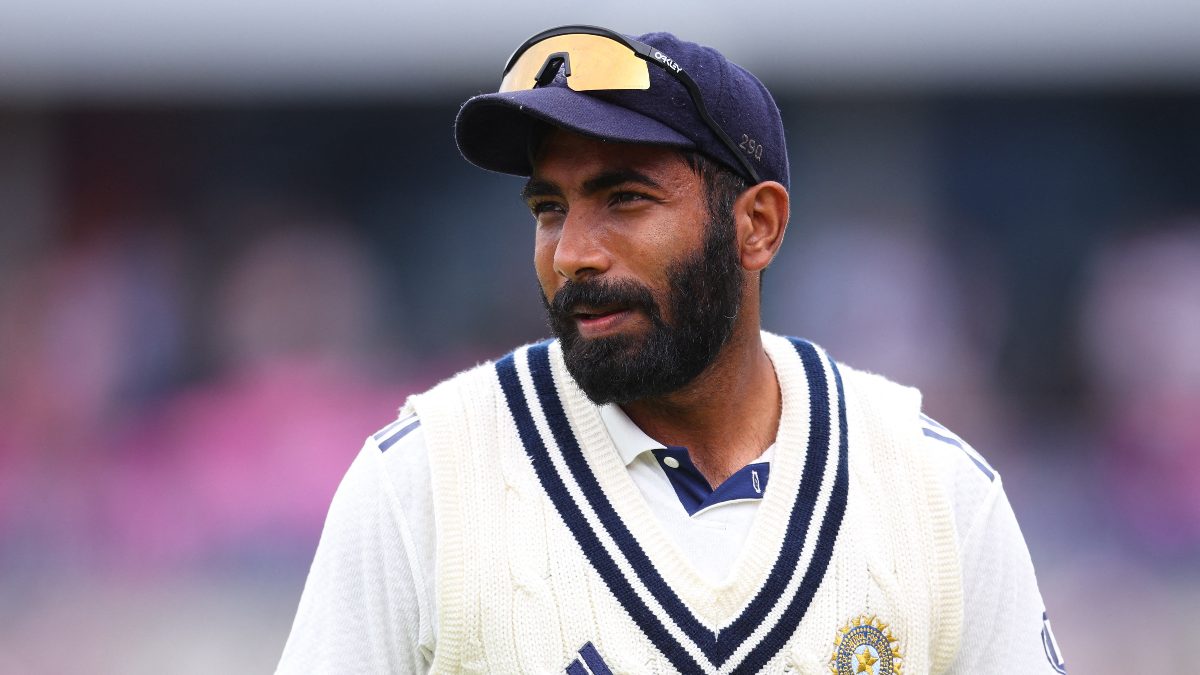When Virat Kohli won the toss at the M Chinnaswamy Stadium on a chilly morning in Bengaluru, the greatest curiosity surrounding the match was about the changes to the Indian XI. As Kohli confirmed his intention to bowl first, much to the surprise of many, there was a feeling in the air that this was quite the gamble by the Indian camp, especially after Sunil Gavaskar had said that it was a bat-first wicket. After all, this was only the second time ever that a captain winning the toss in Bengaluru had opted to bowl first and the first instance was in 1974 in the first Test ever played at the venue. Despite a hint of moisture on the pitch and a thin cloud cover, this was a track with cracks where batting fourth could be tricky and the best batting conditions would be early in the Test match. [caption id=“attachment_2506660” align=“alignleft” width=“380”]  R Ashwin (R) celebrates with Virat Kohli (C) on the first day of the second Test. AFP[/caption] At the end of the day, with South Africa dismissed for 214 in 59 overs and Murali Vijay, Shikhar Dhawan putting up an unbeaten 80-run opening stand, it is fair to say Kohli’s gamble has paid off handsomely – partly by design and partly by lack of application from the South African batsmen. “Been raining for the last week, so there is moisture deep inside the surface and we predict it will do something all day.” That was Kohli’s verdict at the toss and he had picked Stuart Binny to replace AB de Villiers’ tormentor in Mohali – Amit Mishra. Binny was even given the new ball. But, despite a sleepy start from the South African openers, Ishant Sharma and Binny did not make the pitch look like Leeds or Durban’s. It was that man from Chennai again, Ravichandran Ashwin, who provided India the breakthrough early in the session. Continuing the tendency to give short spells to his bowlers, Kohli brought on Ashwin as first-change in the eighth over despite having three seamers in his side. But Ashwin struck immediately, twice in his first over in fact, first removing Stiaan van Zyl and then the dangerous but out-of-form Faf du Plessis. Cheteshwar Pujara’s reflex catch at short-leg, grabbing the ball from inches off the ground to send back du Plessis, was remarkable - though replays indicated that the catch stood only because there was not enough evidence to overrule the on-field call. Those two early dismissals would set the trend for what was to follow for the rest of the South African innings, both in terms of the bowling and the catching. Ashwin went on to take four wickets and so did comeback-man Ravindra Jadeja, as South Africa crumbled against the spinners on a ‘not-so-spinny’ track again. Varun Aaron, with arguably the ball of the day, sent back Hashim Amla early as well when he played around an angled ball that moved away just a little bit to send the off-stump cartwheeling. But, as much as the bowling, some of the catches India took on the field on Saturday were breathtaking and played a key part in the dominating position that India find themselves in at the end of day one. There was Ajinkya Rahane’s low catch to dismiss JP Duminy at first slip that he made seem as easy as pie, when it was anything but. Stuart Binny also brought out his best Kapil Dev imitation, to run backwards for yards from mid-on and diving full length to get rid of Morne Morkel. But the best of the lot, not just for the sheer skill, but for the importance of the wicket, was Wriddhiman Saha’s effort to send back AB de Villiers. Till then, like he often does, de Villiers made it look like he was batting on a completely different pitch to the rest of his teammates. Flicking with those powerful wrists, slapping the ball over the fast bowlers’ head with authority, sweeping with power and finesse, and even dancing down the track to defend the ball with a dead bat – ABD was intent on making the Test his own. Right on the stroke of tea, however, from an innocuous Jadeja delivery from around the wicket, de Villiers got an inside edge on to the pads that looped up but looked like it would land in the vacant short leg region. But Saha had other ideas – he scampered a few steps, put in a full length dive forward with his left-arm stretched, and with the last inch of the webbing in his big gloves, gathered the ball cleanly before tumbling over. With de Villiers looking set to join the elite club of centurions on their 100th Test, Saha’s catch at the stroke of tea handed India a big boost. After letting the tail wag for just a little bit, Ashwin and Jadeja wrapped up the innings. Murali Vijay and Shikhar Dhawan, in their brief stay looked comfortable in the middle as India put on their highest opening partnership since the Test match against Bangladesh in Fatullah earlier this year, ending a run of eight innings without a 50-run opening stand. Kohli’s decision to bowl first – and by extension, bat fourth – hinged heavily on his bowlers coming good on the first day. And they did just that, aided partly by some daft Test batting by South Africa and a field day for his catchers. It is now up to the Indian batsmen to make it count.
Kohli’s decision to bowl first – and by extension, bat fourth – hinged heavily on his bowler’s coming good on the first day. And they did just that, aided partly by some daft Test batting by South Africa and a field day for his catchers.
Advertisement
End of Article


)

)
)
)
)
)
)
)
)



